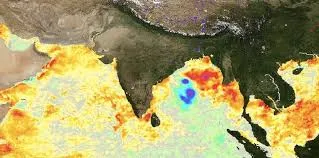Indian Ocean Climate Study
A major international climate study focusing on the Indian Ocean has revealed critical changes in oceanic patterns and their impact on global weather systems. The study, conducted over five years by scientists from India, Australia, and the UK, highlights warming sea surface temperatures and shifting monsoon patterns. The Indian Ocean, which influences rainfall over South Asia, Africa, and parts of Australia, is experiencing rapid climate induced transformations. Researchers noted that the Western Indian Ocean is warming faster than the global average, intensifying extreme weather events such as cyclones, floods, and prolonged droughts. Data from satellite observations and deep sea buoys were used to assess the Indian Ocean Dipole (IOD) and its erratic behavior in recent years. A positive IOD typically results in better monsoon rainfall over India but can cause droughts in Australia and Indonesia. However, the study warns that traditional patterns are now harder to predict. The warming trend is affecting marine ecosystems as well, with coral bleaching events and a decline in fish populations observed in several regions. Indian researchers from the National Institute of Oceanography played a key role in deploying sensors and analyzing data from the Arabian Sea and Bay of Bengal. The findings call for urgent climate mitigation efforts, including better forecasting systems, sustainable marine management, and regional cooperation on disaster preparedness. The Indian Ocean, often overshadowed by the Pacific in climate discourse, is now seen as central to understanding the planet’s changing climate.





 Reuters Bitcoin hits record $116,781 fueled by institutional demand
Reuters Bitcoin hits record $116,781 fueled by institutional demand  New Bill on Data Protection Tabled
New Bill on Data Protection Tabled  South Korea, U.S., Japan conduct air drill with B 52 bomber over Peninsula
South Korea, U.S., Japan conduct air drill with B 52 bomber over Peninsula  IMD Predicts Two Week Dry Spell in North and Central India
IMD Predicts Two Week Dry Spell in North and Central India  Finland notifies U.N. of withdrawal from landmine ban treaty
Finland notifies U.N. of withdrawal from landmine ban treaty